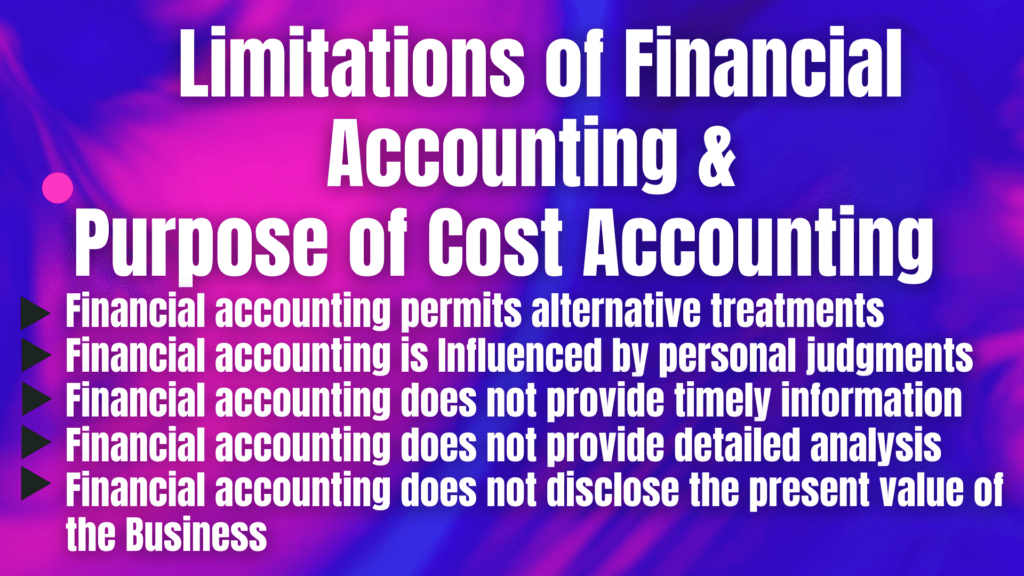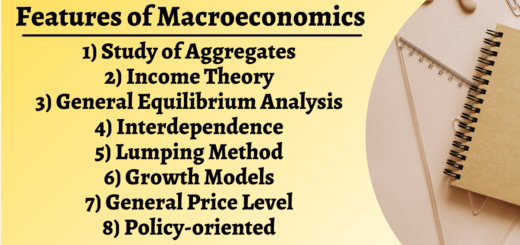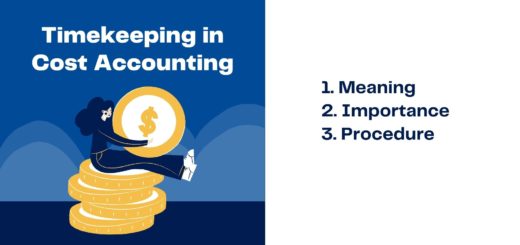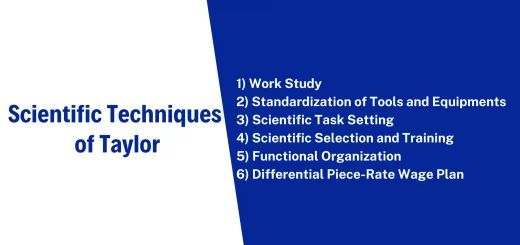Limitations of Financial Accounting | Purpose of Cost Accounting
Limitations of Financial Accounting

Meaning and Definition of Financial Accounting
Financial accounting is the area of accounting that focuses on providing external users with useful information. In other words, financial accounting is a way of reporting business activity and financial information to investors, creditors, and other people outside the business organization.
Financial Accounting refers to the Bookkeeping of financial transactions by classifying, analyzing, summarizing, and recording financial transactions like purchases, Sales, Receivables, and Payables and finally preparing the Financial Statements which include Income Statement Balance Sheet & Cash Flows.
Keeping track of records and creating a summary of financial transactions is called bookkeeping – When this information is produced and displayed in reports for the use of the public outside the company, this process is called financial accounting. The key difference between financial and managerial accounting is that financial accounting is aimed at providing information to parties outside the organization. Whereas managerial accounting information is aimed at helping managers within the organization make decisions.
Limitations of Financial Accounting
The advantages of accounting do not suggest that accounting is free from limitations. Anyone who is using accounting information should be well aware of its limitations.
The Following are the limitations:
(a) Financial accounting permits alternative treatments:
No doubt accounting is based on concepts and follows “generally accepted accounting principles”, but there exists more than one principle for treating any one item. This permits alternative treatments within the framework of generally accepted accounting principles. For example, the closing stock of a business may be valued by any one of the following methods: FIFO (First-in-first-out); LIFO (Last-in-first-out); Average price, Standard price, etc., Application of different methods will give different results but the methods are generally accepted. So, the results are not comparable.
(b) Financial accounting is Influenced by personal judgments:
Even though the convention of objectivity is respected in accounting but to record certain events, estimates have to be made which requires personal judgment. It is very difficult to expect accuracy in future estimates and objectivity suffers. For example, to determine the amount of depreciation to be charged every year for the use of a fixed asset, it is required to estimate (a) the future life of the asset, and (b) the scrap value of the asset. Thus, in accounting, we do not determine but measure the income. In other words, the income disclosed by accounting is not authoritative but an approximation.
(c) Financial accounting ignores important non-monetary information:
Financial accounting takes into consideration only those transactions and events which can be described in money. The transactions and events, however important, if non-monetary are ignored i.e., not recorded. For example, extent of competition faced by the business, technical innovations possessed by the business, loyalty and efficiency of the employees etc. are the important matters in which management of the business is highly interested but accounting is not tailored to take note of such matters. Thus, any user of financial information is, naturally, deprived of vital information which is of non-monetary character.
(d) Financial accounting does not provide timely information:
Financial accounting is designed to supply information in the form of statements (Balance Sheet and Profit and Loss Account) for a period, normally, one year. So the information is, at best, of historical interest and only postmortem analysis of the past can be conducted. The business requires timely information at frequent intervals to enable the management to plan and take corrective action. For example, if a business has budgeted that during the current year sales should be Rs. 12,00,000 then it requires information – whether the sales in the first month of the year amounted to Rs. 1,00,000 or less or more? Traditionally, financial accounting is not supposed to supply information at shorter
intervals than one year.
(e) Financial accounting does not provide detailed analysis:
The information supplied by the financial accounting is in reality aggregate of the financial transactions during the year. Of course, it enables to study of the overall results of the business activity during the accounting period. For proper running of the business, information is required regarding the cost, revenue, and profit of each product but financial accounting does not provide such detailed information product-wise. For example, if a business has earned a total profit of, say, Rs. 5,00,000 during the accounting year and it sells three products namely petrol, diesel, and mobile oil, and wants to know the profit earned by each product. Financial accounting is not likely to help him.
(f) Financial accounting does not disclose the present value of the business:
In financial accounting, the position of the business as on a particular date is shown by a statement known as a balance sheet. In the balance sheet, the assets are shown based on the going concern concept. Thus, it is presumed that business has a relatively long life and will continue to exist indefinitely, hence the asset values are going concern values. The realized value of each asset if sold today can’t be known by studying the balance sheet.
Financial accounting is developed over time to record, summarise, and present the financial transactions or events which can be expressed in terms of money. This function was primarily concerned with record keeping, leading to the preparation of Profit and Loss Account and Balance Sheet.
The information obtained through financial statements is useful to the Management or Owner in several respects. However, the information provided by financial accounting is not sufficient for several purposes of decision-making in many areas such as: determining output level, determining product selection – addition or dropping or changing product combination in the case of multi-product company, determining or revising prices of products, whether Profit earned is optimum as compared with competitors and in comparison to earlier years. The need for data for such details leads to the development of Cost Accountancy.


